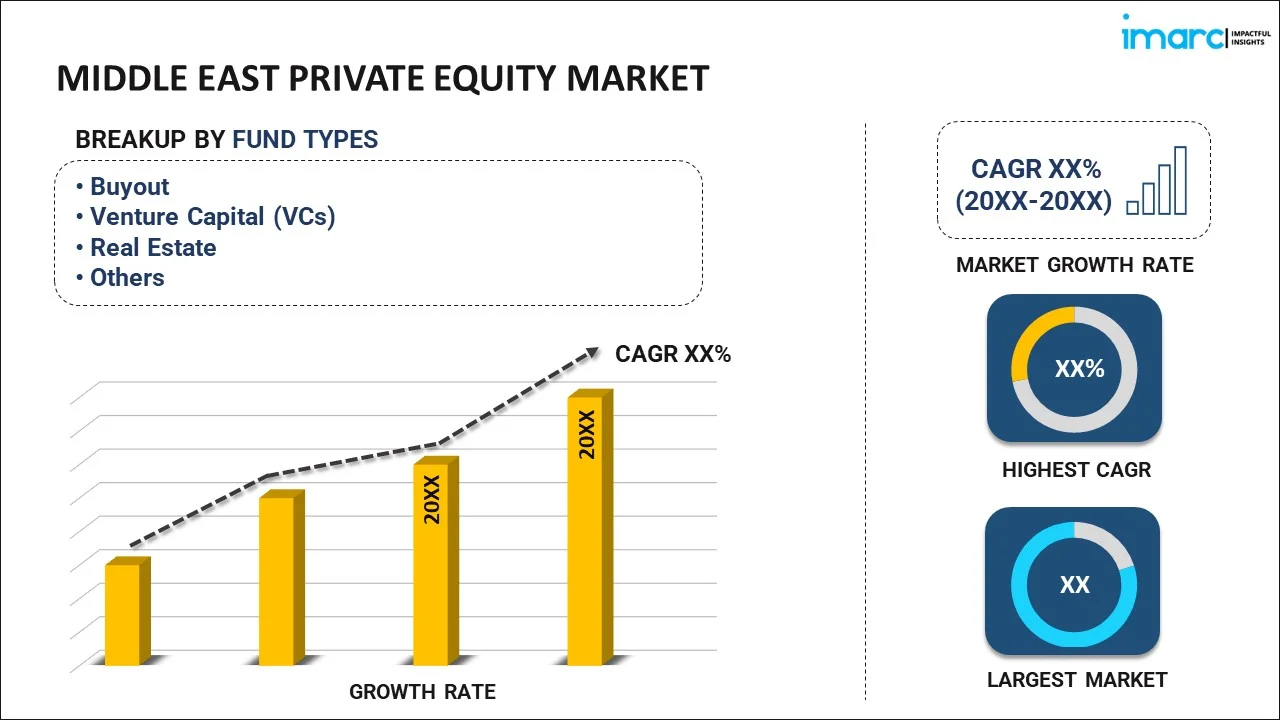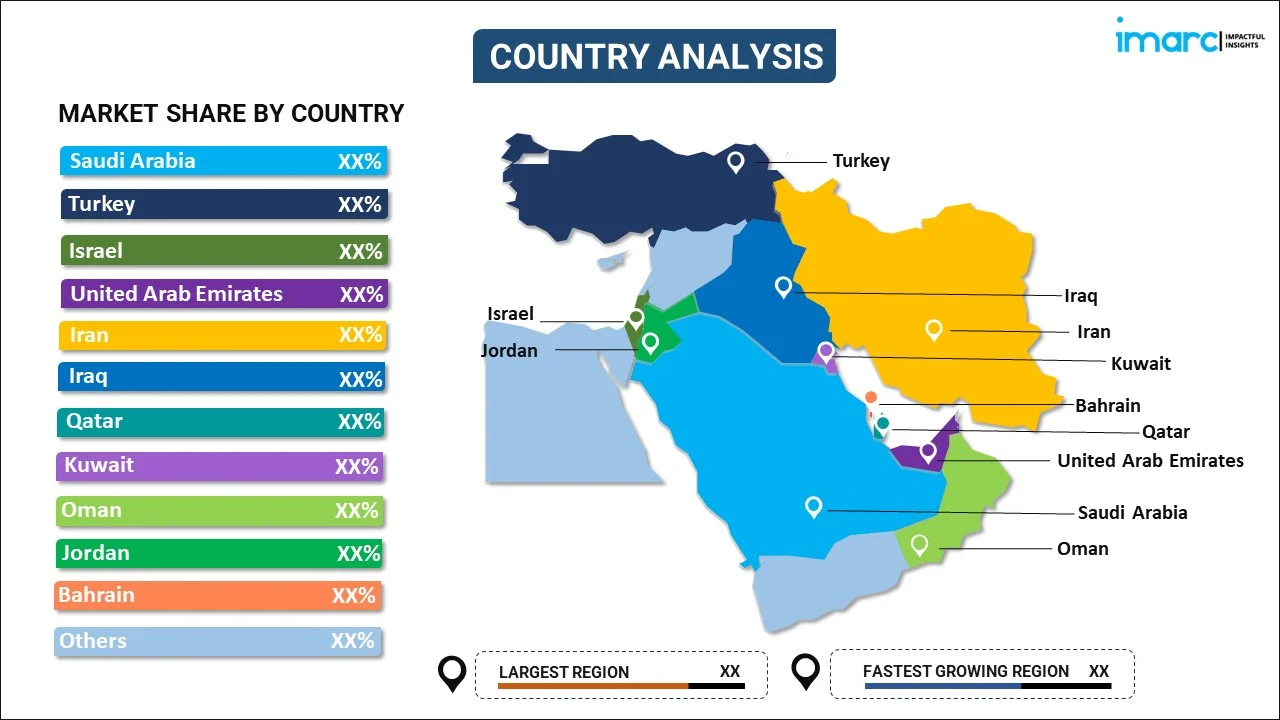
Middle East Private Equity Market Report by Fund Type (Buyout, Venture Capital (VCs), Real Estate, Infrastructure, and Others), and Country 2026-2034
Market Overview:
Middle East private equity market size reached USD 21,063.4 Million in 2025. Looking forward, IMARC Group expects the market to reach USD 36,837.3 Million by 2034, exhibiting a growth rate (CAGR) of 6.41% during 2026-2034. The increasing availability of attractive exit opportunities, such as initial public offerings (IPOs), acquisitions, or secondary market sales, which enhance the potential for profitable returns, is driving the market.
|
Report Attribute
|
Key Statistics
|
|---|---|
|
Base Year
|
2025
|
|
Forecast Years
|
2026-2034
|
|
Historical Years
|
2020-2025
|
|
Market Size in 2025
|
USD 21,063.4 Million |
|
Market Forecast in 2034
|
USD 36,837.3 Million |
| Market Growth Rate 2026-2034 | 6.41% |
Access the full market insights report Request Sample
Private equity refers to a form of investment where funds are pooled from institutional and high-net-worth investors to acquire, invest in, or provide financing for privately held companies. These investments are typically not traded on public stock exchanges. Private equity firms raise capital to create investment funds, and their goal is to generate returns by actively managing and improving the performance of the companies in which they invest. This involvement often includes strategic decision-making, operational improvements, and, at times, restructuring. Private equity investments are known for their longer investment horizon, typically spanning several years. The returns for investors come from the eventual sale of the investments, either through a public offering or a private sale, with profits distributed among the fund's limited partners. The private equity industry plays a crucial role in fostering entrepreneurship, driving operational efficiency, and contributing to economic growth.
Middle East Private Equity Market Trends:
The private equity market in the Middle East is multifaceted, encompassing various factors that collectively shape the industry's dynamics. Firstly, economic conditions play a pivotal role in steering private equity activities. During periods of robust economic growth, investors are more inclined to deploy capital into private equity ventures, seeking higher returns in a favorable market environment. Moreover, technological advancements serve as catalysts for change in the private equity landscape. The digital era has spurred innovation and disruption across industries, creating opportunities for private equity firms to invest in emerging technologies and transformative business models. Additionally, regulatory frameworks exert a significant influence, shaping the operating environment for private equity. Changes in regulations can impact deal structures, fundraising strategies, and overall market competitiveness. In essence, the private equity market in the Middle East is a dynamic ecosystem where economic trends, technological advancements, and regulatory shifts, collectively propel its evolution.
Middle East Private Equity Market Segmentation:
IMARC Group provides an analysis of the key trends in each segment of the market, along with forecasts at the regional and country levels for 2026-2034. Our report has categorized the market based on fund type.
Fund Type Insights:

To get detailed segment analysis of this market Request Sample
- Buyout
- Venture Capital (VCs)
- Real Estate
- Infrastructure
- Others
The report has provided a detailed breakup and analysis of the market based on the fund type. This includes buyout, venture capital (VCs), real estate, infrastructure, and others.
Country Insights:

To get detailed regional analysis of this market Request Sample
- Saudi Arabia
- Turkey
- Israel
- United Arab Emirates
- Iran
- Iraq
- Qatar
- Kuwait
- Oman
- Jordan
- Bahrain
- Others
The report has also provided a comprehensive analysis of all the major regional markets, which include Saudi Arabia, Turkey, Israel, United Arab Emirates, Iran, Iraq, Qatar, Kuwait, Oman, Jordan, Bahrain, and Others.
Competitive Landscape:
The market research report has also provided a comprehensive analysis of the competitive landscape in the market. Competitive analysis such as market structure, key player positioning, top winning strategies, competitive dashboard, and company evaluation quadrant has been covered in the report. Also, detailed profiles of all major companies have been provided.
Middle East Private Equity Market Report Coverage:
| Report Features | Details |
|---|---|
| Base Year of the Analysis | 2025 |
| Historical Period | 2020-2025 |
| Forecast Period | 2026-2034 |
| Units | Million USD |
| Scope of the Report | Exploration of Historical Trends and Market Outlook, Industry Catalysts and Challenges, Segment-Wise Historical and Future Market Assessment:
|
| Fund Types Covered | Buyout, Venture Capital (VCs), Real Estate, Infrastructure, Others |
| Countries Covered | Saudi Arabia, Turkey, Israel, United Arab Emirates, Iran, Iraq, Qatar, Kuwait, Oman, Jordan, Bahrain, Others |
| Customization Scope | 10% Free Customization |
| Post-Sale Analyst Support | 10-12 Weeks |
| Delivery Format | PDF and Excel through Email (We can also provide the editable version of the report in PPT/Word format on special request) |
Key Questions Answered in This Report:
- How has the Middle East private equity market performed so far and how will it perform in the coming years?
- What is the breakup of the Middle East private equity market on the basis of fund type?
- What are the various stages in the value chain of the Middle East private equity market?
- What are the key driving factors and challenges in Middle East private equity?
- What is the structure of the Middle East private equity market and who are the key players?
- What is the degree of competition in the Middle East private equity market?
Key Benefits for Stakeholders:
- IMARC’s industry report offers a comprehensive quantitative analysis of various market segments, historical and current market trends, market forecasts, and dynamics of the Middle East private equity market from 2020-2034.
- The research report provides the latest information on the market drivers, challenges, and opportunities in the Middle East private equity market.
- Porter's five forces analysis assist stakeholders in assessing the impact of new entrants, competitive rivalry, supplier power, buyer power, and the threat of substitution. It helps stakeholders to analyze the level of competition within the Middle East private equity industry and its attractiveness.
- A competitive landscape allows stakeholders to understand their competitive environment and provides an insight into the current positions of key players in the market.
Need more help?
- Speak to our experienced analysts for insights on the current market scenarios.
- Include additional segments and countries to customize the report as per your requirement.
- Gain an unparalleled competitive advantage in your domain by understanding how to utilize the report and positively impacting your operations and revenue.
- For further assistance, please connect with our analysts.
 Request Customization
Request Customization
 Speak to an Analyst
Speak to an Analyst
 Request Brochure
Request Brochure
 Inquire Before Buying
Inquire Before Buying




.webp)




.webp)












